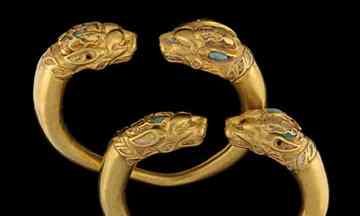Some of Afghanistan's most beautiful treasures will be on display at the British Museum this spring, including a crown made for a princess 2,000 years ago that was believed lost as war engulfed the country but survived thanks to the courage of staff in the national museum.
 More than 20,000 golden objects, including figurines, belts, bracelets and dress ornaments, were found in six tombs in the north of the country in 1978 – the eve of the Soviet invasion.
More than 20,000 golden objects, including figurines, belts, bracelets and dress ornaments, were found in six tombs in the north of the country in 1978 – the eve of the Soviet invasion.
The finds at a site so rich it was named Tillya Tepe – "the hill of gold" – quickly acquired legendary status. Few had ever set eyes on them apart from the team led by the Greco-Russian archaeologist Victor Sarigiannidis and a handful of staff at the national museum in Kabul. Then the treasures vanished without trace, believed possibly melted down and smuggled out as bullion.
The Kabul museum was closed, looted, occupied by a militia, bombed, and targeted by religious extremists who smashed thousands of ancient sculptures. But the gold survived, hidden in strong boxes in the national bank.
Fredrik Hiebert, an archaeologist with National Geographic, had been on the trail of the gold for almost 20 years since he heard the story from Sarigiannidis. Both men were present six years ago when the boxes were finally opened.
"It was a life-changing moment," Hiebert said at the British Museum. "Out of the boxes came some dirty plastic bags, and out of them the gold. There were 30 Afghans in the room with us, and I waited for a cheer, a moment of euphoric recognition, but it didn't come. "How do we know it's real?" they asked. Most of them were in their 20s, and they had only heard of the gold, they had never seen it. And then Sarigiannidis recognised a repair in one piece that he had made himself so long before, and that was the moment of euphoria."
They will be among the stars of the exhibition, called Afghanistan: Crossroads of the Ancient World, which opens at the British Museum on 3 March.
The subtitle was very deliberate, said the museum's director, Neil MacGregor.
"We hope to demonstrate that we are at a historically anomalous moment when the country is seen as remote and isolated," he said. "Afghanistan's relationships are long and deep."
The paintings of the Italian Renaissance could not have happened without Afghan lapis lazuli, he said – the stone ground up to supply dazzling blues.
The 200 objects on display will include Mesopotamian-influenced gold from 2,000BC, Indian-inspired ivory fittings and Greek carvings from the outpost of Alexander the Great's empire. The show will also include delicate coloured glass from palaces founded when the nomadic tribes settled and coveted the Hellenic luxuries they had first destroyed.
Curators and conservation workers from Kabul will work at the British Museum during the exhibition – helping to identify some of the smuggled antiquities that have been pouring out of Afghanistan and were intercepted by UK customs authorities. Untold quantities will inevitably have got through and vanished forever into the black market.
The exhibition has already been seen in Europe and the US. The hope in Afghanistan is that when it closes in London on 3 July some of the treasures will go back to Kabul. The museum is open again, but has only photographs of the gold to remind its people of their heritage, so nearly lost forever.
Author: Maev Kennedy | Source: Guardian [November 29, 2010]